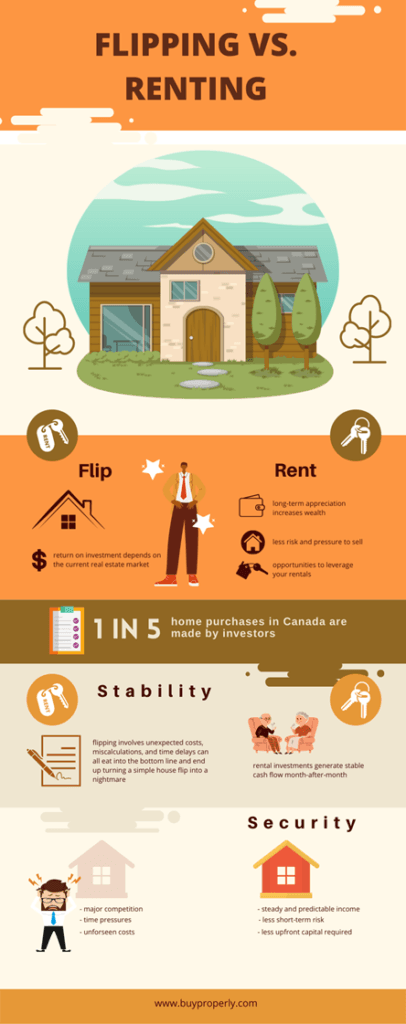Flipping vs Renting: Which Strategy is Better for Real Estate Investors?

When it comes to real estate investing, there’s a lot of debate about whether flipping or renting is the best way to go. Both options have their pros and cons, so it can be tough to decide which property investment strategy to start with. In this blog post, we’ll take a closer look at flipping vs renting, and help you decide which option is better for you.
The difference between flipping and buying to rent is that flipping entails selling a house after purchasing it (often after a few months), whereas with ‘rental income’ real estate investments are meant to be long-term.
Let’s dive into the pros and cons for both investment strategies so you can decide which one will help you reach your financial goals!
What is house flipping?
House flipping is when an investor buys a house, renovates it, and then, ideally, sells it for more than what they paid for it. The flipping process can be done very quickly – in some cases the entire flips can be done in only 4-6 months!
When flipping properties, the best strategy is to find and buy houses for below market value. These properties are normally in need of major renovation work which gives investors an opportunity to increase the value in a relatively short period of time.

The pros of house flipping
Many investors love the house-flipping model. Here’s why…
– Flipping offers a quick return on investment. Once an investor finds a property, it can be renovated, listed, and resold in a matter of months.
– There are different financing options available. Some investors qualify for renovation loans which allows them to spend less money out-of-pocket for their flips.
– It’s a repeatable process. Investors simply find houses below market value, renovate them and sell ASAP for more than the purchase plus renovation cost. This simple formula can be applied to 5, 10, 20, or even 100 properties!
The cons of house flipping
Although flipping houses can seem like a quick and lucrative way to invest, it’s not without risk. Here are some things to consider…
– Flipping can be risky. Large amounts of capital are tied to the purchase and there’s pressure to relist the house quickly. This may lead to mistakes that could be costly – such as paying too much for a property or renovating it incorrectly.
– Flipping properties is competitive! In order to be successful, investors need to find houses either below market value OR with tremendous potential to be updated. Hundreds of other investors are also searching for the same thing, which can ultimately drive up prices.
– Flipping can be stressful and time-consuming. It’s a fast-paced project with several deadlines and moving parts. Many investors find the prospect of flipping to be too overwhelming for their lifestyle.
– House flipping relies on finding the right contractors. Investors who choose to rehab and resell houses must find reputable contractors who understand renovations, pricing, and project management. Hiring the wrong contractors can lead to bad renovation decisions, wasted time, overspending, and, potentially, zero profit.
What happens when house flipping goes wrong?
Sometimes, rehabbing and reselling houses can go majorly wrong. The flipping process involves purchasing a property, renovating it and then selling it as quickly as possible to make a profit. If investors run into any issues during this process it can be costly.
Here are some common flipping fails to be aware of:
Getting over-extended
Flipping houses takes a significant amount of capital, and this can quickly take a toll on investors. Unexpected costs, miscalculations, and time delays can all eat into the bottom line and end up turning a simple house flip into a nightmare.
Buying the wrong houses
Because flipping is competitive, there may be a lot of investors bidding for the best houses and snatching them up quickly. You want to make sure you’re buying properties that aren’t overpriced or in need of too much work to be profitable.
Not finding flipping deals
Making a lucrative income from flipping is 100% dependent on finding the right properties. Some investors either get impatient or they get overwhelmed by the competition and end up over-bidding on properties. Overpaying is a common mistake when investors are looking during a hot real estate market.
What is rental income real estate investing?
Rental income real estate investing is a strategy where investors purchase properties with the intent to rent them for a monthly income. This is also known as a buy-and-hold and is a more long-term investment approach.
The main difference between flipping and rental income real estate investing is that flipping entails selling the property immediately after renovation work has been completed, whereas with rental income properties, the intent is to hold onto the investment for a longer period of time – typically 5-20 years.
The pros of rental properties
Purchasing rental properties tends to be a more common strategy for most real estate investors. Here are some of the major reasons why…
– Rental income real estate investing is generally less stressful than flipping, as investors have more time to find and purchase a rental property due to the longer holding period. As a result, renting alleviates pressure from making quick decisions.
– Rental income investing is less risky than flipping. Instead of focusing on flipping for a quick profit, rental properties are meant to be held for multiple years which results in more time to make adaptations and improvements to the property when required.
– Buying rental properties can be inexpensive compared to flipping. The costs associated with flipping often include significant renovation fees and improvements. This means investors expect to put down an additional 20-30% of the purchase price for flipping costs. With rental properties, the capital can be put directly towards the purchase with an immediate opportunity for cash flow.
-With rental properties, investors get to take advantage of long-term property appreciation. At the same time, they’re able to generate consistent income in the years between property renovations or while the housing market is slow.
-Rental investors aren’t as affected by sudden dips in the housing market. A buy-and-hold strategy allows investors to weather the storm and wait for a more favorable market before deciding to sell.
The cons of rental properties
Although rental property investments can create a lot of financial security and stability, no investment strategy is perfect. Let’s take a look at some cons of buying rentals.
– Renting does not bring in money immediately. The income that you’ll be making will be spread over the entire time you own the property, which means the profit is not received in one lump sum as flipping would provide.
– Traditional rental income real estate requires large amounts of capital. Like flipping, purchasing rental properties does involve some costs (i.e. down payment brokerage fee, land transfer tax, legal fees, etc.).
-Rental properties are not as liquid as flipping which means they cannot be sold as quickly and easily if a sudden need arises.
– Rentals take time and money to manage. Investors must choose to handle maintenance, repairs, showings, rentals, and emergencies on their own, or find a reputable property management company to handle the job.
Today, there are many options for investors to buy into real estate without the huge upfront costs. At BuyProperly, we use a fractional ownership model that allows people to buy real estate for as little as $2500 to start. With this type of investment, you don’t have to dedicate time to finding tenants, managing the property, and taking care of all the operational details. Check out our properties to get started.
Which investment strategy is better for you?
Deciding between flipping vs renting real estate comes down to your goals, lifestyle, and preferences. Flipping is a riskier investment strategy and certainly not for the faint of heart. It takes time and energy finding, prepping, and selling properties, and it also takes time to learn the ins and outs of your local market.
Most people feel more comfortable starting with rental investments. They require less immediate capital and the holding period is longer, which provides more time for renovation work and improvements.
There are also fantastic tax benefits for landlords and investors get to take advantage of long-term appreciation on the property. Not to mention, owning multiple rental properties gives investors more leverage to continue investing and building their portfolios.
The bottom line is, rental properties allow you to grow a lucrative, stable portfolio and they’re perfect for investors who want to build wealth with predictable cash flow and appreciation.
Are rental property investments best for beginners?
The best strategy for beginners is the one that they’re most comfortable with. More often than not, this ends up being buy-and-hold properties like single-family and duplex rentals. Real estate has historically shown dependable growth of property values, it has also been able to deliver consistent cash flow for those investors.
However, a major issue for many new investors is the time and dedication it takes to manage a rental property. But there’s no need to let this stand in your way! There are companies that can help take care of day-to-day management, rentals, and maintenance required to keep a property running smoothly, making your investment more passive than ever.
Here at BuyProperly, we make real estate investing easy and accessible for everyone using a fractional ownership model. Our mission is to enable investors to grow wealth through alternate asset classes. With real estate investing you are receiving a rent payment that is not only consistent in timing but also in the amount.
We provide regular investors with the benefits of investing in rapidly growing cities with huge capital appreciation without bearing the brunt of high real estate costs and the challenges of managing and operating a rental property. We take care of everything – all you need to do is select the property to invest in and watch your investment grow!
Eager to learn more? Visit BuyProperly
Read about Why Invest in Real Estate: 7 Key Benefits to Know | Buyproperly
Conclusion
The bottom line is that flipping vs renting real estate depends on the individual investor’s preferences and lifestyle.
With flipping, you can generate wealth quickly – but flipping also requires a lot of time and attention to detail with no room for error. Buying rental properties takes longer to grow your income portfolio but carries significantly less risk. It’s normally a better choice for investors who are looking for a more passive income approach.
Here at BuyProperly, we love helping investors find rental properties that can generate passive income and grow their wealth.
If you’re interested in learning more about how you can grow your real estate portfolio without a massive cash deposit (or all the headaches!) Download our eBook here.